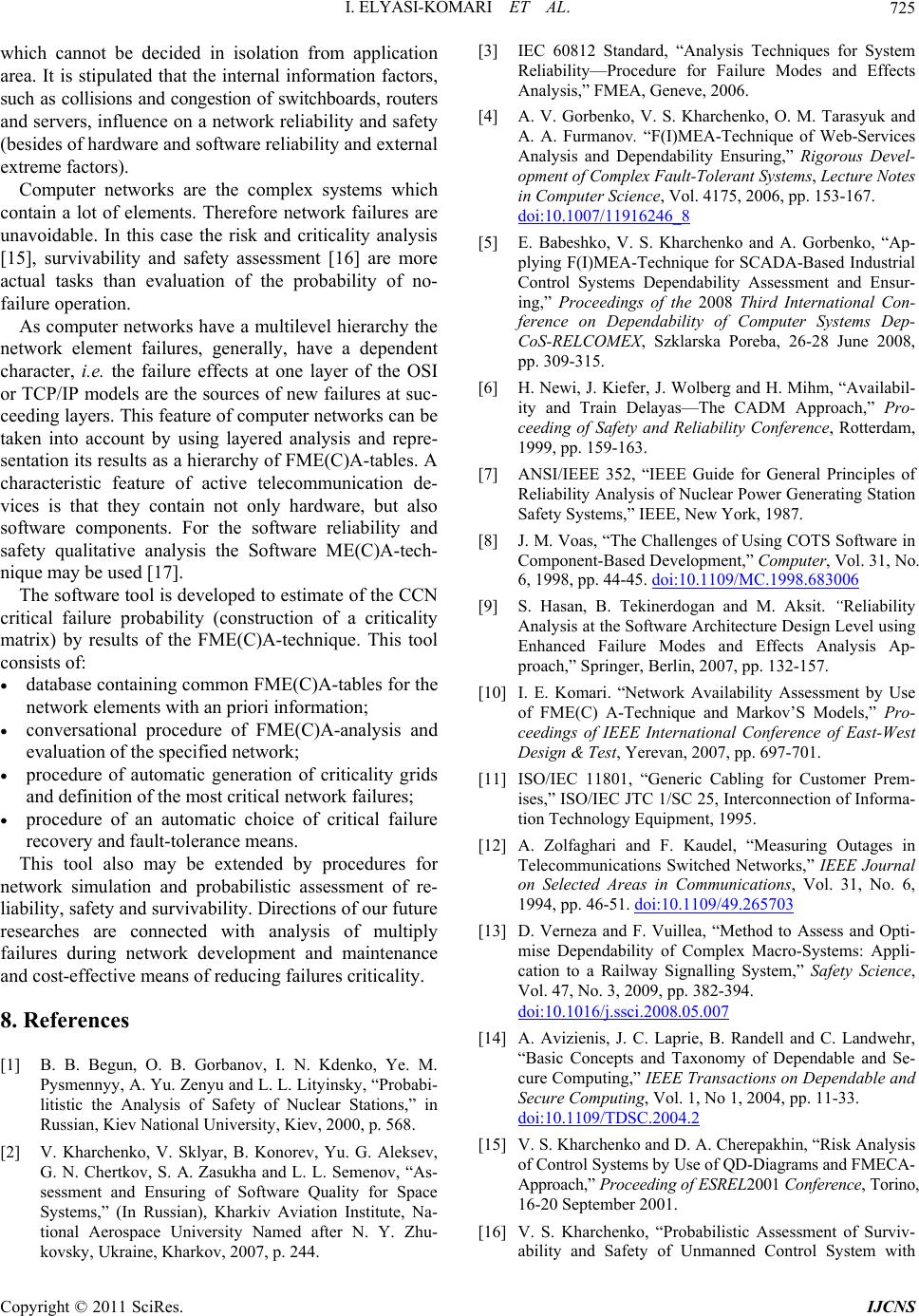
I. ELYASI-KOMARI ET AL.
Copyright © 2011 SciRes. IJCNS
725
which cannot be decided in isolation from application
area. It is stipulated that the internal information factors,
such as collisions and congestion of switchboards, routers
and servers, influence on a network reliability and safety
(besides of hardware and software reliability and external
extreme factors).
Computer networks are the complex systems which
contain a lot of elements. Therefore network failures are
unavoidable. In this case the risk and criticality analysis
[15], survivability and safety assessment [16] are more
actual tasks than evaluation of the probability of no-
failure operation.
As computer networks have a multilevel hierarchy the
network element failures, generally, have a dependent
character, i.e. the failure effects at one layer of the OSI
or TCP/IP models are the sources of new failures at suc-
ceeding layers. This feature of computer networks can be
taken into account by using layered analysis and repre-
sentation its results as a hierarchy of FME(C)A-tables. A
characteristic feature of active telecommunication de-
vices is that they contain not only hardware, but also
software components. For the software reliability and
safety qualitative analysis the Software ME(C)A-tech-
nique may be used [17].
The software tool is developed to estimate of the CCN
critical failure probability (construction of a criticality
matrix) by results of the FME(C)A-technique. This tool
consists of:
database containing common FME(C)A-tables for the
network elements with an priori information;
conversational procedure of FME(C)A-analysis and
evaluation of the specified network;
procedure of automatic generation of criticality grids
and definition of the most critical network failures;
procedure of an automatic choice of critical failure
recovery and fault-tolerance means.
This tool also may be extended by procedures for
network simulation and probabilistic assessment of re-
liability, safety and survivability. Directions of our future
researches are connected with analysis of multiply
failures during network development and maintenance
and cost-effective means of reducing failures criticality.
8. References
[1] B. B. Begun, O. B. Gorbanov, I. N. Kdenko, Ye. M.
Pysmennyy, A. Yu. Zenyu and L. L. Lityinsky, “Probabi-
litistic the Analysis of Safety of Nuclear Stations,” in
Russian, Kiev National University, Kiev, 2000, p. 568.
[2] V. Kharchenko, V. Sklyar, B. Konorev, Yu. G. Аleksev,
G. N. Chertkov, S. А. Zasukha and L. L. Semenov, “As-
sessment and Ensuring of Software Quality for Space
Systems,” (In Russian), Kharkiv Aviation Institute, Na-
tional Aerospace University Named after N. Y. Zhu-
kovsky, Ukraine, Kharkov, 2007, p. 244.
[3] IEC 60812 Standard, “Analysis Techniques for System
Reliability—Procedure for Failure Modes and Effects
Analysis,” FMEA, Geneve, 2006.
[4] A. V. Gorbenko, V. S. Kharchenko, O. M. Tarasyuk and
A. A. Furmanov. “F(I)MEA-Technique of Web-Services
Analysis and Dependability Ensuring,” Rigorous Devel-
opment of Complex Fault-Tolerant Systems, Lecture Notes
in Computer Science, Vol. 4175, 2006, pp. 153-167.
doi:10.1007/11916246_8
[5] E. Babeshko, V. S. Kharchenko and A. Gorbenko, “Ap-
plying F(I)MEA-Technique for SCADA-Based Industrial
Control Systems Dependability Assessment and Ensur-
ing,” Proceedings of the 2008 Third International Con-
ference on Dependability of Computer Systems Dep-
CoS-RELCOMEX, Szklarska Poreba, 26-28 June 2008,
pp. 309-315.
[6] H. Newi, J. Kiefer, J. Wolberg and H. Mihm, “Availabil-
ity and Train Delayas—The CADM Approach,” Pro-
ceeding of Safety and Reliability Conference, Rotterdam,
1999, pp. 159-163.
[7] ANSI/IEEE 352, “IEEE Guide for General Principles of
Reliability Analysis of Nuclear Power Generating Station
Safety Systems,” IEEE, New York, 1987.
[8] J. M. Voas, “The Challenges of Using COTS Software in
Component-Based Development,” Computer, Vol. 31, No.
6, 1998, pp. 44-45. doi:10.1109/MC.1998.683006
[9] S. Hasan, B. Tekinerdogan and M. Aksit. “Reliability
Analysis at the Software Architecture Design Level using
Enhanced Failure Modes and Effects Analysis Ap-
proach,” Springer, Berlin, 2007, pp. 132-157.
[10] I. E. Komari. “Network Availability Assessment by Use
of FME(C) A-Technique and Markov’S Models,” Pro-
ceedings of IEEE International Conference of East-West
Design & Test, Yerevan, 2007, pp. 697-701.
[11] ISO/IEC 11801, “Generic Cabling for Customer Prem-
ises,” ISO/IEC JTC 1/SC 25, Interconnection of Informa-
tion Technology Equipment, 1995.
[12] A. Zolfaghari and F. Kaudel, “Measuring Outages in
Telecommunications Switched Networks,” IEEE Journal
on Selected Areas in Communications, Vol. 31, No. 6,
1994, pp. 46-51. doi:10.1109/49.265703
[13] D. Verneza and F. Vuillea, “Method to Assess and Opti-
mise Dependability of Complex Macro-Systems: Appli-
cation to a Railway Signalling System,” Safety Science,
Vol. 47, No. 3, 2009, pp. 382-394.
doi:10.1016/j.ssci.2008.05.007
[14] A. Avizienis, J. C. Laprie, B. Randell and C. Landwehr,
“Basic Concepts and Taxonomy of Dependable and Se-
cure Computing,” IEEE Transactions on Dependable and
Secure Computing, Vol. 1, No 1, 2004, pp. 11-33.
doi:10.1109/TDSC.2004.2
[15] V. S. Kharchenko and D. A. Cherepakhin, “Risk Analysis
of Control Systems by Use of QD-Diagrams and FMECA-
Approach,” Proc eeding of ESREL 2001 Conference, Torino,
16-20 September 2001.
[16] V. S. Kharchenko, “Probabilistic Assessment of Surviv-
ability and Safety of Unmanned Control System with